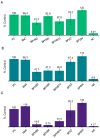Development of Antimicrobial Blends of Bacteria Nanocellulose Derived from Plastic Waste and Polyhydroxybutyrate Enhanced with Essential Oils
- PMID: 39771342
- PMCID: PMC11728516
- DOI: 10.3390/polym16243490
Development of Antimicrobial Blends of Bacteria Nanocellulose Derived from Plastic Waste and Polyhydroxybutyrate Enhanced with Essential Oils
Abstract
The escalating global concern regarding plastic waste accumulation and its detrimental environmental impact has driven the exploration of sustainable alternatives to conventional petroleum-based plastics. This study investigates the development of antimicrobial blends of bacterial nanocellulose (BNC) derived from plastic waste and polyhydroxyalkanoates (PHB), further enhanced with essential oils. The antimicrobial activity of the resulting BNC/PHB blends was tested in vitro against Escherichia coli, Staphylococcus aureus, and Candida albicans. The incorporation of essential oils, particularly cinnamon oil, significantly enhanced the antimicrobial properties of the BNC/PHB blends. The BNC with 5% PHB blend exhibited the highest antifungal inhibition against C. albicans at 90.25%. Additionally, blends with 2% and 10% PHB also showed antifungal activity, inhibiting 68% of C. albicans growth. These findings highlight the potential of incorporating essential oils into BNC/PHB blends to create effective antimicrobial materials. The study concludes that enhancing the antimicrobial properties of BNC/PHB significantly broadens its potential applications across various sectors, including wound dressings, nanofiltration masks, controlled-release fertilizers, and active packaging.
Keywords: antimicrobial blends; bacterial nanocellulose; biopolymers; polyhydroxyalkanoates.
Conflict of interest statement
The authors declare no conflicts of interest.
Figures












References
-
- Pan D., Su F., Liu C., Guo Z. Research Progress for Plastic Waste Management and Manufacture of Value-Added Products. Adv. Compos. Hybrid Mater. 2020;3:443–461. doi: 10.1007/s42114-020-00190-0. - DOI
-
- RameshKumar S., Shaiju P., O’Connor K.E. Bio-Based and Biodegradable Polymers—State-of-the-Art, Challenges and Emerging Trends. Curr. Opin. Green Sustain. Chem. 2020;21:75–81. doi: 10.1016/j.cogsc.2019.12.005. - DOI
Grants and funding
LinkOut - more resources
Full Text Sources

